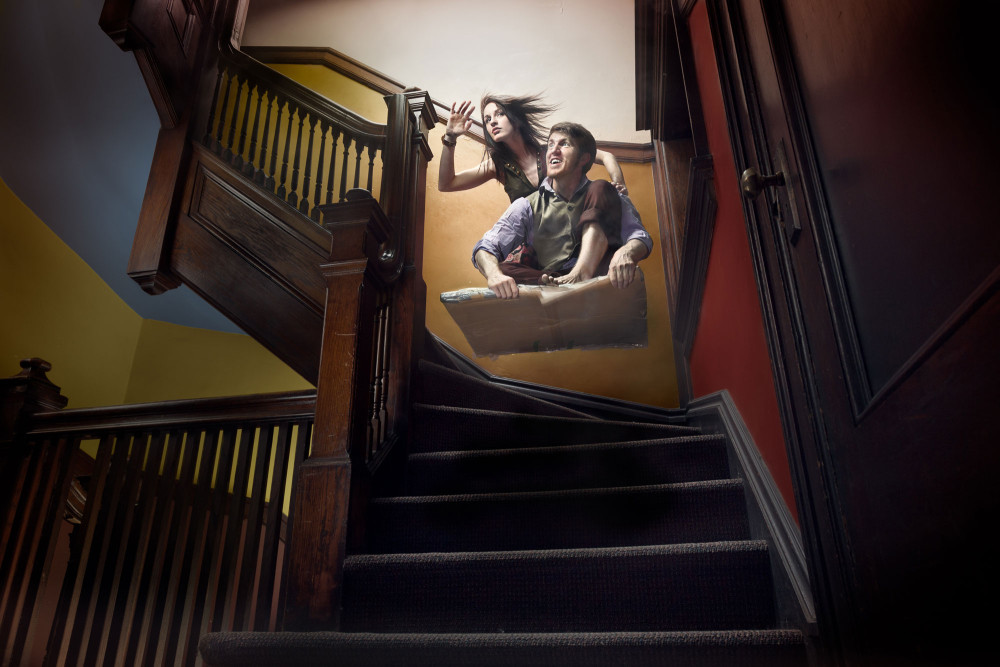
New Game Country
Process is an interesting idea that can be interpreted a number of ways. I know some people place it as either the primary focus of the work, or it’s downplayed to focus on the concept. I’ve always hovered somewhere in the middle. For me, the very origin of an idea, a concept, rests within process. Concept informs process. Process informs concept. The two are always stepping on each other’s toes. I never stop thinking about the idea during any stage of process, but I also try to not have it dialed in during any early stage, either.
I’m often writing. I have stacks and stacks of short story snippets crammed in binders. These often are the beginnings to a new image. My goal is to never photograph that story, but instead use it as my starting point. When I teach workshops on storytelling and location lighting, I always begin with a dry erase marker and an empty board for a full imagination. I lead classes in creative writing exercises before we ever talk about camera mechanics. We blast through word trees and spontaneous responses until we begin to make connections for a possible scenario. That rough idea will serve as a vague blueprint for the final image. The primary mindset is the story we’ll be telling… but in either my personal work or during workshops, I never want to know the full story. Just a brief glimpse.
The image I’m discussing in this writing was made in Winnipeg during the summer of 2013. I was on a cross-continent road trip making photographs with actors/models across 8,000+ miles of America and Canada. I stopped in a new city every two days or so to tell a new story. In Winnipeg, the awesome Emily Wood, originally from London, hosted me at her apartment and was the actress in the photo. She’s also a writer and a singer/musician. The fantastic Tim Redford, also a singer and musician, assisted on the shoot.
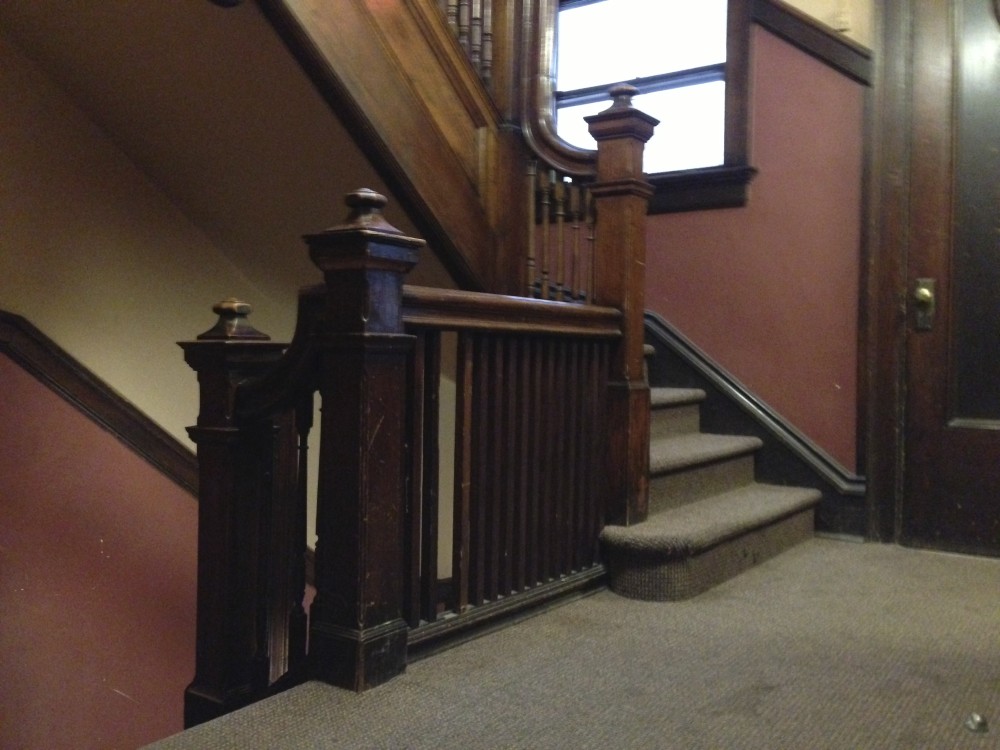
After writing a story, I draw a crude storyboard to help let others in on my imagination. For this shoot, my starting point was a short story about two people trapped inside of a board game. How do they react? What is their mission while in there? Do they want to get out? Emily had sent me images a few weeks prior of the inside of her apartment complex so I knew roughly where we’d be shooting. Incidentally, it’s one of the most haunted places in Winnipeg. Luckily I didn’t know that at the time, because I’m terrified of stuff like that. But even with a secured location, I still needed to get the specifics down on the actual frame.
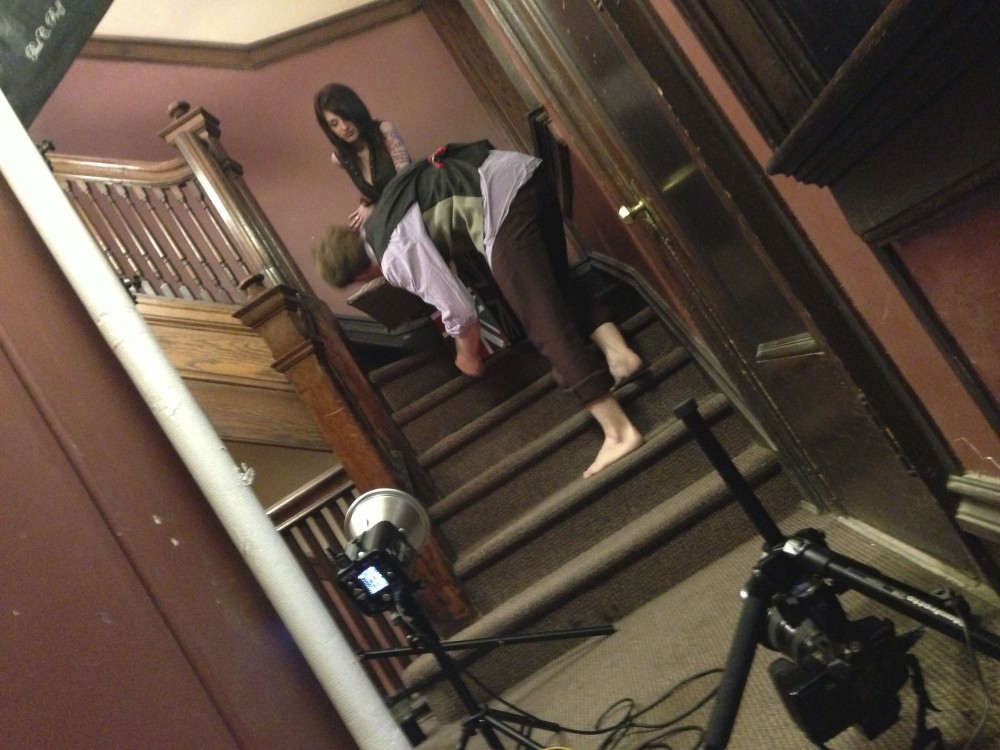
I spend the longest time setting up the composition. I can’t overstate how important it is to be technically sound in not just how your camera works button-wise, but in how it alters perception. Don’t just set your camera for a correct exposure. Set it for the correct everything. A 24mm focal length will yield an entirely different image and emotion than a 70mm focal length. A low, center, or high angle will create psychological vantage points. Adjust shutter based upon how motion will be depicted. A clear understanding of design theory is important when looking at not just WHO you’re photographing, but by how a landscape and its infinite lines are also a form of storytelling. How do you know everything is correct? Experiment with compositional choices over, and over… and over again. Ultimately, this will become the backbone of your image. Give yourself the time you need to find it.
Once I have my composition, I lock it in on a tripod and don’t let it move. Lighting is for two potential purposes: to eliminate shadows, or to be the unseen extra character in the frame. Think about which role each light will be performing as they’re moved into the frame for the scene.
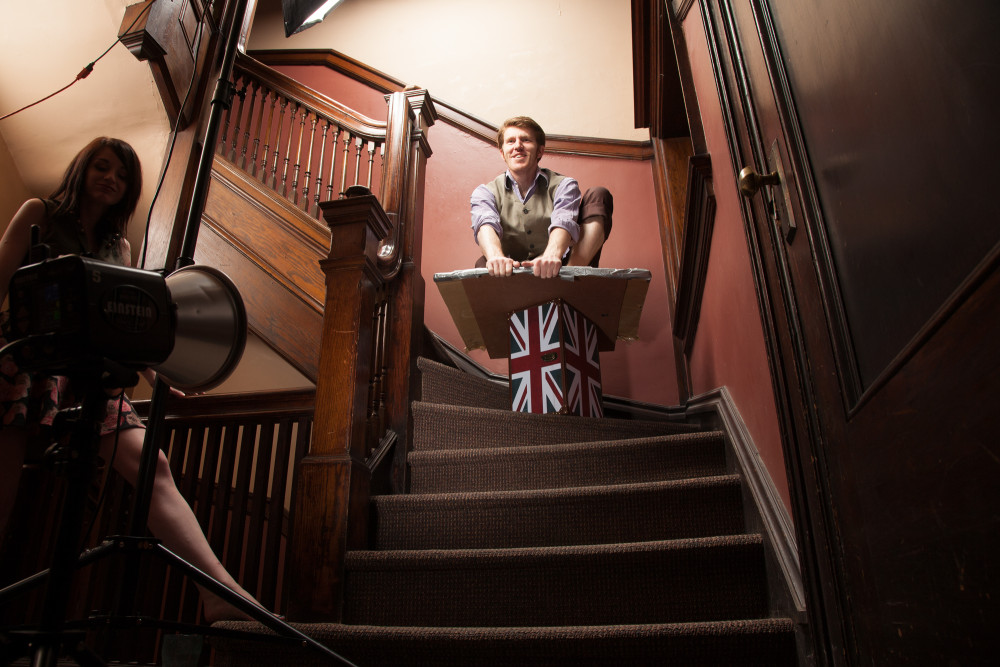
Once all of this is in place (and this might take a few hours) it’s finally time to transform a photo set into an improv theater production. Some of the most fun in making a photo is the opportunity to experiment and try things in front of the camera (whether it’s yourself or you’re living vicariously through the actors you’re directing). Think of it as being a movie actor for a single frame. If someone is bashful and would have a horrible time delivering lines, acting for the still camera alleviates that problem. But it’s helpful if they can “speak” without words. Body posture, facial expressions, all of this is important in conveying emotion. I’m not a big fan of people holding in place. Rather, I like to have everyone really do what’s happening in the frame. Really jumping. Really straining. Really running. Whatever the action is. I really wanted to be jumping down the stairs while holding this cardboard, but the potential for broken actor bones forced me to creatively solve the dilemma of gravity, while still enabling us to be within the space and live acting the scene. People don’t lie when they’re actually doing what they’re trying to pretend to do. I remember asking Emily if I was very good at giving directions for models. She laughed and said I was horrible. I took it as a compliment. I’m more curious in seeing how someone reacts to a scenario. Where will we take the initial spark of a story?
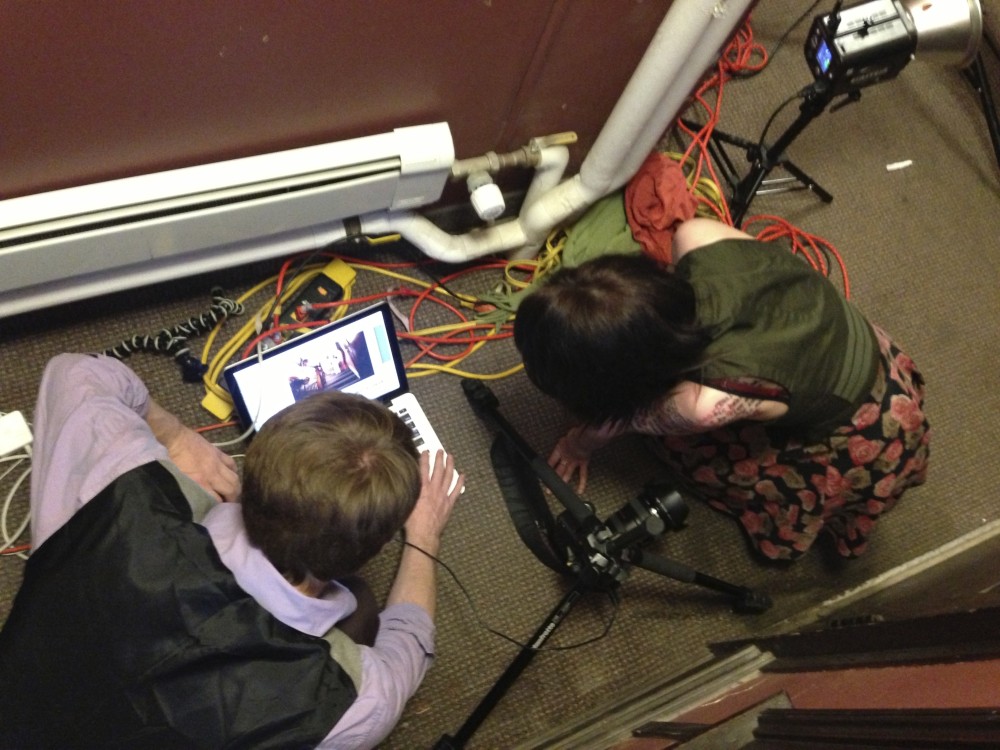
The camera was tethered to a laptop, so every 30-40 takes, we’d review what we had. The original idea is our starting point, but in the middle of shoots, I access what is or is not working and make adjustments on the fly (no pun intended). Maybe the initial story isn’t coming through strong enough yet, or perhaps there’s a better story forming from the act of make believe.
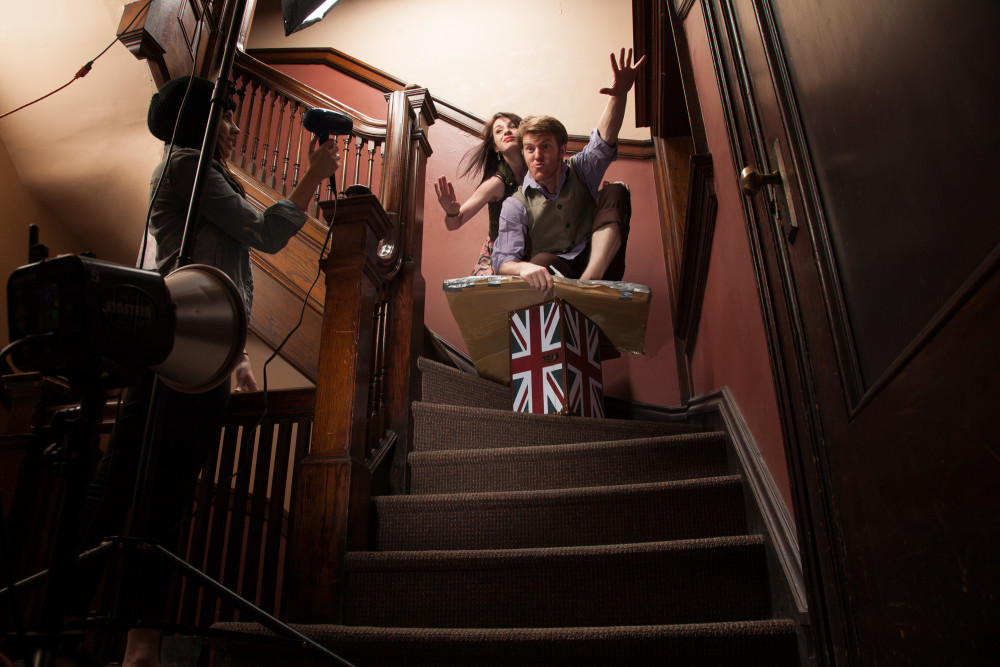
I’m not bashful about including random people in a photograph, either as an extra or for an assistant. Tim had awesomely agreed to run the shutter for me. Every three seconds, I asked him, just click the button. Later, I’d sort out the expressions. During this shoot, we weren’t getting enough hair motion despite all of our shuffling about on the precariously mounted cardboard. Down the hall, someone was walking to her apartment so I asked if she had a spare 5 minutes… and a hair dryer. She had both, and ended up hanging out with us for almost the rest of the shoot. Her roommate even brought out homemade cookies during. I’m a big believer in keeping a relaxed shoot, being spontaneous, and not forgetting to have fun. I also find that the more prepared I am for a shoot, the easier it is to relax within the world I’ve constructed.
I try not to fret about lighting overall outside of the “action” portion of the image. I’ll have light stands in frame, blown out back sections, whatever. I consider a photograph to be made up of lots of smaller segments. I want the lighting on the focus (people, an object, etc) to be as ideal as possible. I’ll worry about the lighting elsewhere afterwards.
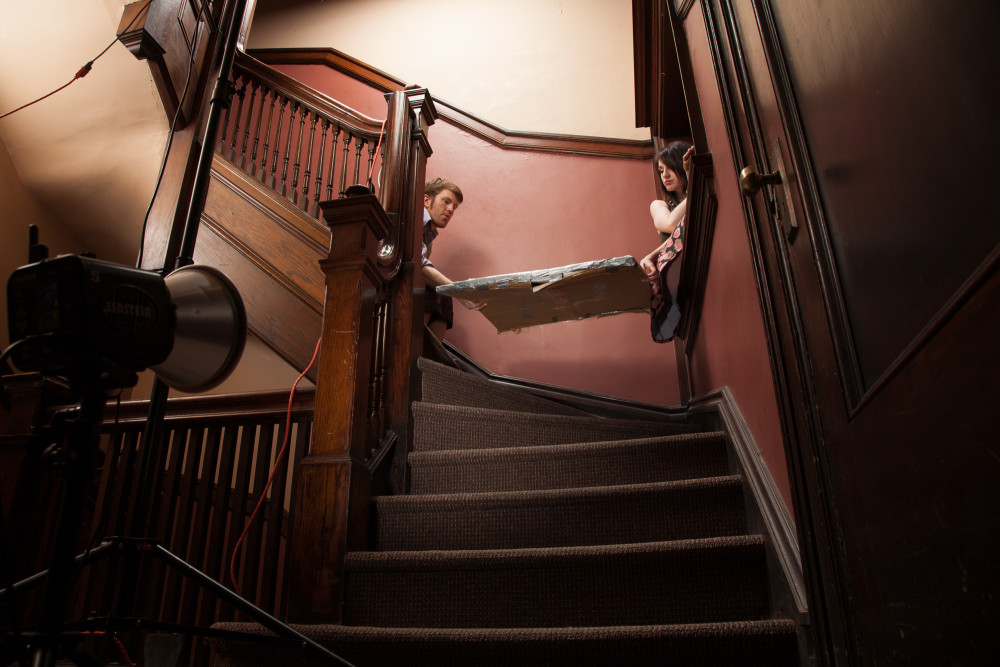
In this photo, it was particularly tricky to get the lighting correct on us, while also eliminating any reflections or visible stands. So, I initially just worried about the lighting on us. My entire studio, including sandbags, fits in my car’s trunk. It’s a mix of Paul Buff monoheads and a couple speedlights, along with a general set of modifiers. Working on the road with borrowed assistants for nearly every shoot, I’ve learned how to use a relatively small lighting equipment list and also minimize the invested time for any volunteers. Could I flag everything off as needed and use multiple boom stands and clamps to achieve all of this in one shot? Yes. But if I think a little more broadly and consider future steps in the computer, I can design a photo set around the post-production process. I relight a scene multiple times after the action of the main content has been accomplished. I can capture different shutter speeds for ambient light. Anything and everything can be within the composition, as long as it isn’t intersecting with main actions in the core regions of the frame. All I need is one exposure of a light stand or power cord in a different position, and I can mask things together once I get to the computer.
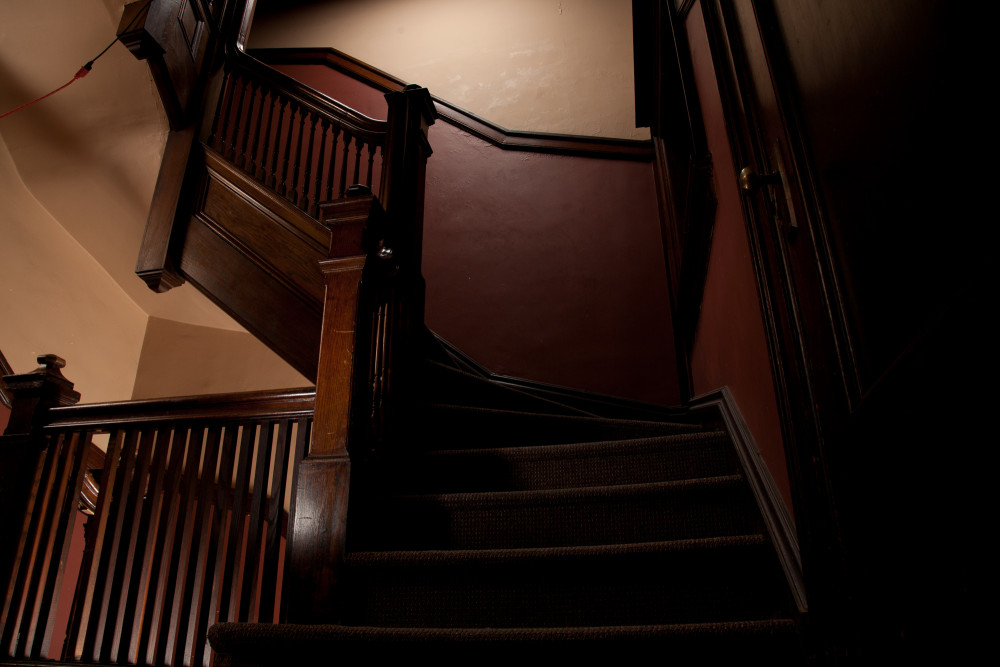
I should note that this isn’t a hard rule. Location dictates how flexible I can be. If I’m racing against available sunlight with mixed strobes, or there’s something else happening that’s out of my control, then I’ll work to get as much of the frame “correct” in one click. So everything becomes relative, but the big picture is knowing where you’re coming from, where you’re going, and having the self-confidence in your abilities for the steps after to allow for greater flexibility. This adds to the potential for relaxation, even in the middle of a shoot where you’re balancing on top of a Union Jack chest.
Once I’m in the computer, this is my ultimate playground. I’ve taken a story from text, then reinterpreted it as actions. Finally, storytelling is again taking place through the choices made in the edit. I equate this process to an editor for a movie. They have all of the pieces from the production, now they just have to put it together.
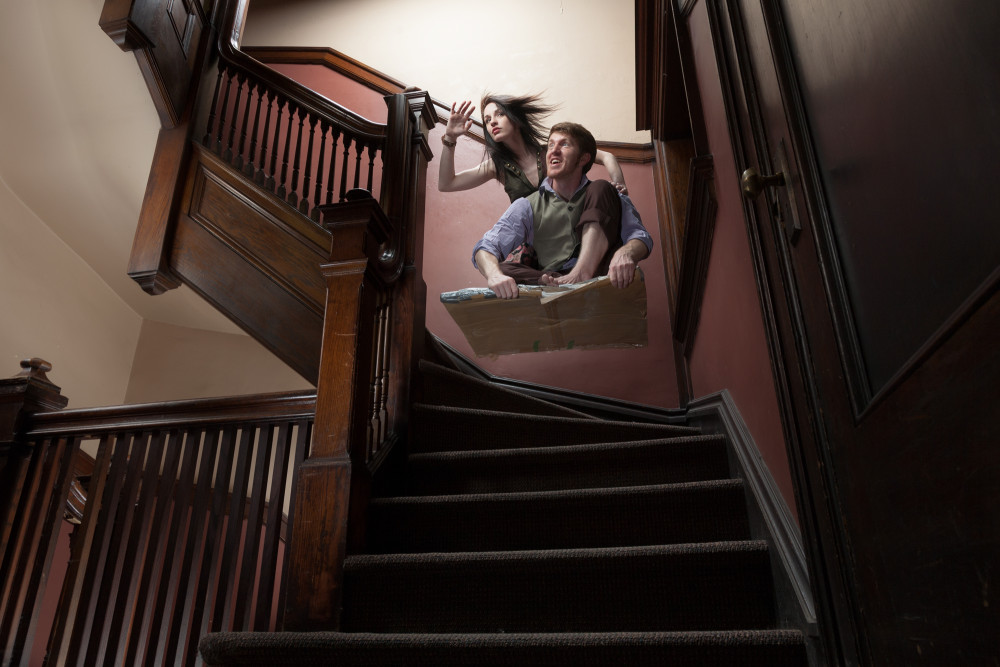
I don’t use Lightroom for anything other than tethering. Photoshop is my software for editing. I start by establishing every frame that can be utilized for a scene. I may have 3-4 frames that contain action elements. By this, I mean that a body posture is great in one take, but a facial expression may be better in another. I’ll mix and match these to create a frame that best summarizes the direction of the image and story (using masking ideally, cloning as a last resort). I also may have 10-15 different relighting frames, done for whatever reasons (eliminate an awkward reflection, add a highlight reflection, illuminate a secondary space, etc etc). My first step is compositing all of that together for a working starting point. Even at this stage, I won’t let myself just connect the dots for finishing an image. That’d be too boring and by the book. I leave open the possibilities for story connections to be found within each segment I’m joining together.
During post-process, music is a big factor in dictating my mindset. My favorite music to edit the starting composite to is either “Imperial March” from Star Wars, or “Ride of the Valkyries” by Wagner. I’ll often just put those two tracks on repeat for an hour or so. The absence of lyrics combined with the forward progression and intensity is a great motivator to soldier through possibly the most laborious part of editing. But once I’m in the color/value editing stages, I’ll frequently switch over to comedy. Tenacious D has been utilized a lot while editing, as has Tim Minchin. In fact, comedians may be as big of an influence for me as photographers. I’ll also play Bloodhound Gang, Guttermouth, the Vandals… music that has a great tempo and reeks of insanity. I also have been known to put on random playlists of dubstep or gangster rap, all at loud volumes. Basically, I don’t edit well to soft and relaxed music. Your individual editing music choices may vary, but this works for me.
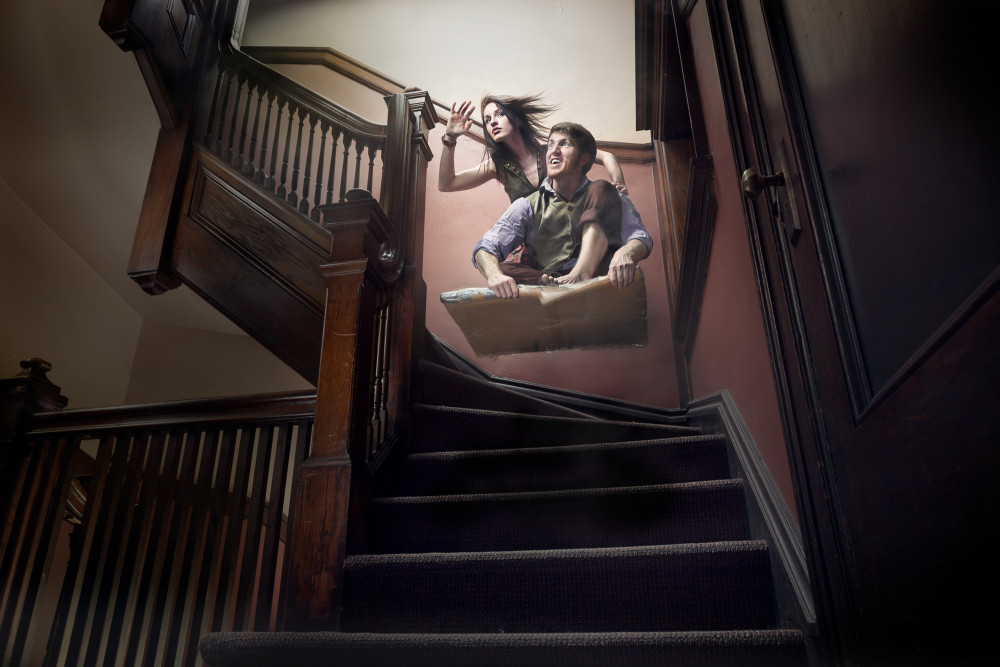
My favorite part of image editing is when I start to use lightness and darkness, and eventually saturation, to direct the viewer’s eye. This mode of thinking begins way back when the lighting is constructed on the set, but is pushed further in software. Knowing how to utilize lighting in the computer gives me more freedom to experiment and take chances with physical lighting. My basic motto is, “Is this important?” If it is, make it brighter. If it’s not, make it darker. All of my edits tend to follow that train of thought. I’ll take a slider and slam it all the way in one direction, just to see where the limits are, and then slowly pull it back. The layers pile up pretty quick, because I tend to work with lots of subtle local edits. In many ways, my editing approach mirrors my shooting approach.
I think back to when I held my niece when she was less than a year old. Her head would bob around until she saw a lightbulb or TV set. For a moment, her eyes would lock in on it and the head bobbing would cease. This is how I consider viewers who are looking at my images. What visual element do I want them to rest a bobbing head on?
When I photographed in the stairwell, I loved the architecture. I loved the depth it provided. I wasn’t crazy about the paint job on the walls, but I didn’t fret it. So when I was at this stage in post-production, my mind went back to my original story idea involving being inside of a board game. I thought of Monopoly, my favorite game ever. Color is used in such an important way to signify different properties (a tip: always purchase the orange properties. Unless we’re playing each other. In that case, pretend this advice was never given). So using my original concept and its related associations as a reference on the edit, I let it guide my color choices in digitally repainting the walls. With this image, it didn’t have to literally become a board game. But a board game was my influence on how to finalize the color palette.

I may spend between 2-24 hours editing a photograph. Sometimes it takes more work to do production, but the post-production goes by quickly. Sometimes it’s the opposite. Sometimes, production and post-production both take a long time (such as with this image). But no matter the time investment, I don’t mind. I enjoy making images.
I enjoy telling stories.
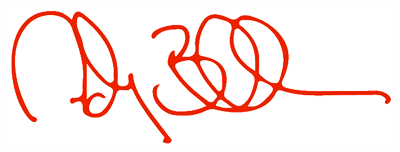
fuchsiag
Mar. 20, 2015YAY!! 🙂
Sierra
Mar. 27, 2015Always a pleasure checking out your work, Andy. I love your writing and the process is very enjoyable to read about! Keep up the good work!